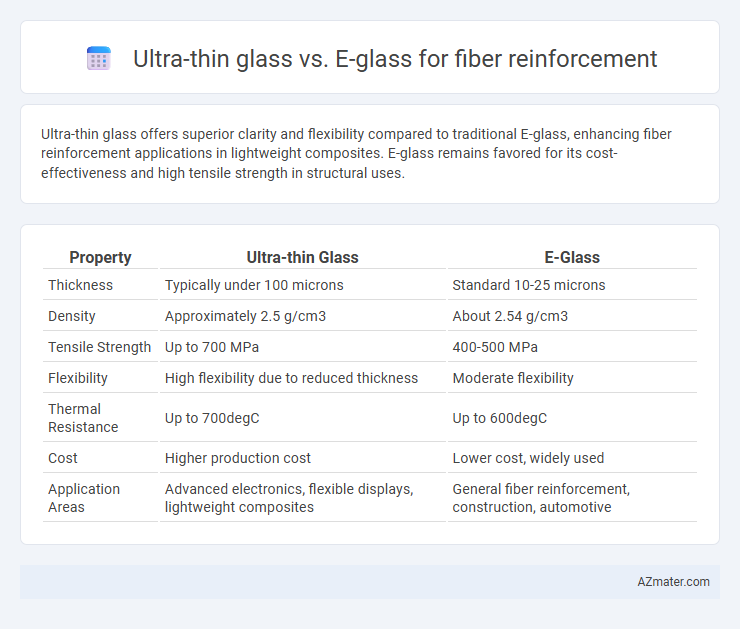Ultra-thin glass offers superior clarity and flexibility compared to traditional E-glass, enhancing fiber reinforcement applications in lightweight composites. E-glass remains favored for its cost-effectiveness and high tensile strength in structural uses.
Table of Comparison
| Property | Ultra-thin Glass | E-Glass |
|---|---|---|
| Thickness | Typically under 100 microns | Standard 10-25 microns |
| Density | Approximately 2.5 g/cm3 | About 2.54 g/cm3 |
| Tensile Strength | Up to 700 MPa | 400-500 MPa |
| Flexibility | High flexibility due to reduced thickness | Moderate flexibility |
| Thermal Resistance | Up to 700degC | Up to 600degC |
| Cost | Higher production cost | Lower cost, widely used |
| Application Areas | Advanced electronics, flexible displays, lightweight composites | General fiber reinforcement, construction, automotive |
Introduction to Fiber Reinforcement Materials
Ultra-thin glass offers superior flexibility and higher tensile strength compared to traditional E-glass, making it an advanced option for fiber reinforcement applications. E-glass, composed primarily of alumino-borosilicate glass, is widely used due to its cost-effectiveness and balanced mechanical properties. The choice between ultra-thin glass and E-glass impacts the composite's weight, durability, and performance in structural and aerospace industries.
Overview of Ultra-thin Glass Fibers
Ultra-thin glass fibers are characterized by diameters typically less than 5 micrometers, offering superior flexibility and higher surface area compared to conventional E-glass fibers with diameters around 10 micrometers. These ultra-thin fibers exhibit improved mechanical properties such as enhanced tensile strength and better interface bonding in composite materials due to their smaller size and increased surface energy. Applications leveraging ultra-thin glass fibers benefit from lightweight, high-strength reinforcement with improved impact resistance and durability.
Characteristics of E-glass Fibers
E-glass fibers, predominantly composed of alumino-borosilicate glass, exhibit high tensile strength, excellent electrical insulation properties, and resistance to chemical corrosion, making them a versatile choice for fiber reinforcement. Their relatively low density and thermal stability enhance performance in lightweight composite applications, while their cost-effectiveness compared to ultra-thin glass fibers ensures widespread industrial use. E-glass fibers also provide reliable mechanical durability and impact resistance, contributing to improved structural integrity in reinforced materials.
Mechanical Properties Comparison
Ultra-thin glass fibers exhibit higher tensile strength and improved flexibility compared to traditional E-glass fibers, resulting in enhanced mechanical performance for fiber-reinforced composites. The reduced diameter of ultra-thin glass leads to increased surface area, facilitating better stress transfer and superior impact resistance. In contrast, E-glass fibers, while cost-effective, demonstrate lower fracture toughness and stiffness, limiting their application in high-performance structural materials.
Flexibility and Formability: Ultra-thin Glass vs E-glass
Ultra-thin glass offers superior flexibility and formability compared to E-glass due to its significantly reduced thickness, allowing it to bend and conform to complex shapes without cracking. E-glass fibers, while strong and rigid, lack the same level of pliability, making them less suitable for applications requiring intricate molding or complex geometries. The enhanced formability of ultra-thin glass improves composite performance in advanced fiber reinforcement applications where flexibility is critical.
Weight Considerations in Composite Applications
Ultra-thin glass fibers significantly reduce the overall weight of composite materials compared to traditional E-glass fibers, enhancing the strength-to-weight ratio essential for aerospace and automotive applications. With fiber diameters often below 10 microns, ultra-thin glass allows for more flexible, lightweight laminates that maintain mechanical integrity while decreasing mass. This weight reduction directly translates to improved fuel efficiency and performance in load-sensitive composite structures.
Thermal and Chemical Resistance
Ultra-thin glass fiber offers superior thermal resistance with a decomposition temperature exceeding 800degC, making it ideal for high-temperature applications compared to E-glass, which typically withstands up to 540degC. Chemically, ultra-thin glass demonstrates enhanced resistance to alkalis and acids, reducing degradation risks in harsh environments where E-glass may suffer from corrosion or weakening. These properties position ultra-thin glass as a preferred choice for composite materials requiring long-term stability under extreme thermal and chemical stresses.
Cost Analysis and Manufacturing Challenges
Ultra-thin glass offers superior mechanical properties and flexibility compared to traditional E-glass, but its higher raw material costs and delicate handling requirements significantly increase overall production expenses. E-glass remains cost-effective due to established manufacturing processes and lower material costs, though it provides lower tensile strength and impact resistance. Manufacturing challenges of ultra-thin glass include stringent quality control, risk of breakage during processing, and the need for specialized equipment, unlike E-glass which benefits from mature, scalable production technologies.
Application Suitability: Industries and Use Cases
Ultra-thin glass fiber offers superior dimensional stability and lightweight properties, making it ideal for high-performance electronics, flexible display substrates, and aerospace components requiring precise tolerances. E-glass fiber, known for its excellent electrical insulation and cost-efficiency, is widely used in automotive parts, marine vessels, and construction materials where durability and affordability are critical. Both materials serve distinct application niches, with ultra-thin glass excelling in advanced technology sectors and E-glass dominating traditional reinforcement markets.
Future Trends in Fiber Reinforcement Technologies
Ultra-thin glass offers superior flexibility and higher tensile strength compared to traditional E-glass, driving advancements in lightweight composite materials for aerospace and automotive industries. Emerging fiber reinforcement technologies focus on integrating ultra-thin glass fibers with nanomaterials to enhance durability and multifunctionality in structural applications. Innovations in manufacturing processes aim to reduce costs and improve scalability, positioning ultra-thin glass as a pivotal material in next-generation fiber-reinforced composites.

Infographic: Ultra-thin glass vs E-glass for Fiber reinforcement
 azmater.com
azmater.com